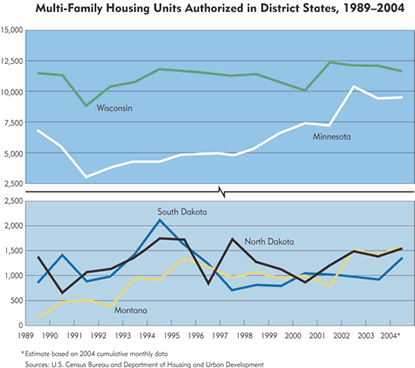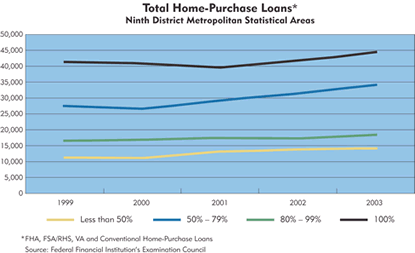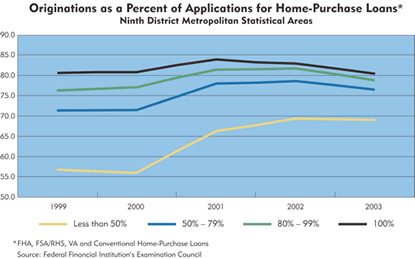 A man's home is his castle. Oh, to be a castle builder these days.
A man's home is his castle. Oh, to be a castle builder these days.
On the heels of a home building spurt over the last four years, "it's still a strong market" in South Dakota, according to Charles Walker of the state's Home Builders Association. "What we're hearing from our members is everybody's busy, and some are busier than others. There still seems to be a trend."
And what a trend it's been virtually everywhere. Annual housing permits in Montana in 2004 were double those of 2000; ditto for North Dakota. Wisconsin was the district "laggard" at an estimated 30 percent growth during this period.
But while headline writers have run out of metaphors for the recent surge of housing, a step back shows that housing activity in the nation and district is actually the continuation of long-running housing growth going back to about 1990. This growth is the result of many factors, including a strong national and district economy that saw employment and income grow, boosting demand for housing along the way.
In 2001, it looked like the house party was about to end, thanks to the recession that eliminated millions of jobs that were comparatively slow to return. This economic shock normally would have pulled the plug on housing demand, at least temporarily, while the economy got back on its feet.
But thanks to dropping interest rates, buyers and builders decided to keep their checkbooks out, unleashing still more housing demand and a burst of new single- and multifamily units over the last four years that has accelerated the housing boom. (Though the word "record" has been thrown about for the last four years, housing numbers nationwide were bigger in the early 1970s, as baby boomers were starting to leave mom and dad's house en masse.)
Across the district, annual housing permits jumped 38 percent from 2000 to 2004. (All statewide figures cited for 2004 are estimates.) In Duluth, Minn., housing permits in 2004 were almost 60 percent higher than in 2000. Activity slowed a bit over the winter, according to Pat Larson, executive officer of the Arrowhead Builders Association, located in Duluth. But among its builder members, "we haven't talked to anyone that's not working," Larson said, adding that the association is planning its biggest-ever Parade of Homes this spring.
(Individual states and metro areas have seen varying activity for both single-family and multifamily units over the last decade and a half. Along with the accompanying charts in this article, see annual permit data for district states and the district's 14 metropolitan statistical areas.)
Leading the housing bonanza is single-family housing, whose permits grew more than 40 percent from 2000 to 2004, and have doubled since 1990. In terms of demand, wealthier households have been active—trading up to a bigger home, finally building that dream home or possibly grabbing their first domicile. That's not particularly surprising: markets always respond to the high end because, well, that's where the money is. Maybe more surprising is the fact that over at least the last decade, homeownership growth has been strongest among lower-income households.

Multifamily housing offers a bit of a contrast. The number of new units authorized in the district zigzagged through the 1990s and has sustained higher activity over 1990 levels only in the last four years, as investors saw lower interest rates since 2001 as a good opportunity to start adding apartments. At the same time, however, two demand plugs got pulled, pushing rental vacancy rates up significantly. While that's bad for owners, it's been good for renters because it's kept a lid on rents after steady increases through the 1990s.

Gimme a slice
First-time buyers have played a prominent role in the home-buying surge in district states. "We're seeing a lot of people moving because of (becoming) first-time buyers," said Lisa Gohrick of Garden City Property Management, which has 800 apartments in the Missoula, Mont., area. "I just had a lady today file [to terminate a lease] because she bought a house."
In Wisconsin, first-time buyers were responsible for over 50 percent of all home purchases during the last two years, according to a survey by the National Association of Realtors. In Minnesota, the first-time buyer rate was 40 percent in 2003, matching the national average.
Walker, from the South Dakota HBA, said the current interest rate environment "makes it more conducive for more young couples to enter the home market." Traditionally, first-timers buyers get their pocketbooks wet by buying an existing home. That's changing too, said Walker. "They are not looking at a starter (existing) home, but a new home."
This crush of first-time home buyers has pushed ownership rates to an all-time high of 69 percent nationwide. Rates are even higher in district states, reaching 77 percent in Minnesota, de facto evidence that homeownership is within reach even for those with modest-to-low incomes, according to Abe Appert, partner of Fransen Appert Real Estate Group in Bloomington, Minn.
"To me, that just sums it up," Appert said. "I don't know that I'd have any more tangible evidence than that."
To get a clearer view of the homeownership trend, the fedgazette collected data on mortgage activity from the district's 14 metro regions from 1999 to 2003 and spliced activity by income levels. (The data come from the Home Mortgage Disclosure Act, collected by the Federal Financial Institution's Examination Council. HMDA requires most metropolitan banks to report mortgage activity. Various studies estimate that HMDA reporting covers about three-quarters of all mortgage originations, whether for purchase or refinance.)
During this period, people earning less than 80 percent of median income applied for and received more mortgages (conventional or government-backed) than those with above-median income, and the annual growth rate of home-purchase originations got stronger as income went down. (See mortgage activity data for individual metro areas.[xls])
Neither is this recent homeownership push among lower-income households an anomaly, despite steadily rising housing prices over the last decade, particularly in metro areas. According to 2003 research by the Joint Center for Housing Studies at Harvard University, the volume of mortgage loans to low-income buyers "surged" by 94 percent from 1993 to 1999, while loans to high-income households grew by 52 percent. A 1999 study by economists with the Federal Reserve System found similar results showing faster growth in mortgage loans among low-income households during the preceding half-decade.

What's pulling that train?
There are many reasons for the growth of homeownership among lower-income households, including cheap and innovative financing. Low interest rates of late, for example, have had the obvious effect of stretching household budgets and making homeownership more affordable (though that has been partially offset by rising home prices).
Also important in convincing lower-income households to own versus rent have been expanded subprime lending and greater availability and sophistication of adjustable rate mortgages. Critics of these financing vehicles have warned of too-loose housing credit. Foreclosure.com, for example, recently reported that properties re-entering the housing market as foreclosures in March rose 57 percent over the same month last year, and the total U.S. inventory of foreclosed homes was up 28 percent from a year earlier. But data from the Mortgage Bankers Association show that national averages for home loan delinquency and foreclosure rates were at modest levels as of the third quarter of 2004, and well below those posted from late 2000 through 2002 and for most of the 1980s; Minnesota rates are well below national averages.
With more financing options available to qualify potential buyers, builders have responded with more housing choices. For example, more condos and townhomes are reportedly getting built, particularly in the Twin Cities (see sidebar). A 2003 report by the National Association of Realtors noted, "A relatively better performance in the condo/co-op market is consistent with the widespread anecdotal stories of the low-end market doing much better than the high-end market."
A final arm of this homeowning hug is public policy, whose roots in promoting homeownership are deep and thick. Way back in the 1930s, Congress created the Federal Housing Administration and the Federal National Mortgage Association (aka Fannie Mae), which ultimately gave birth to the long-term, amortized mortgage, a financing vehicle that made homeownership more affordable. On top of that, additional home ownership programs are scattered liberally among all levels of government, ownership programs are scattered liberally among all levels of government, making for a duplicative network of incentives for homeowners.
At the federal level, the FHA and Veterans Administration offer first-time and low-income buyer programs; the U.S. Department of Agriculture's Section 502 Direct Loan program targets homeownership for low-income rural households. Virtually all states today—indeed, even many cities—also have programs offering below-market interest rates and/or assistance with down payments and closing costs for first-time and low-income home buyers. In 2002 the South Dakota Housing Development Authority was involved with 43 percent of home purchases among low-income, affordable and first-time home buyer markets in the state, according to a 2003 state needs assessment report.
Even public housing programs—typically focused on renters—are shifting some attention toward homeownership. In 2000, HUD began allowing recipients of Section 8 housing vouchers—the nation's largest housing assistance program—to use the assistance toward a mortgage payment rather than rent. Use of this new tool appears limited to date, but the idea is catching on among local housing authorities. Among numerous local anecdotes, the North-west Minnesota Multi-County Housing and Redevelopment Authority has created revolving loan and other programs that have helped 500 households in its sparsely populated region become home buyers since 1998, according to the agency.
Throw in various financial incentives like annual tax deductions for mortgage interest, which dwarf rental assistance programs in terms of cost, and you've got a hearty recipe for homeownership. Numerous sources acknowledged the homeownership bias. Said Appert, "It's almost an unfair competitive strike against the apartment market."
This space for rent
What's often been overlooked amid all of this home-buying activity is its dramatic effect on rental markets, known in real estate lingo as multifamily housing. (Multifamily permits include apartments as well as townhomes and condos, the latter of which are typically owner-occupied.)
During the latter half of the 1990s, the multifamily market was in a bit of a funk. In the district, multifamily permits dropped briefly after 1990 and were generally flat through 2000, though individual states saw varying rates of growth and decline. But low interest rates changed all that as developers saw opportunity in tight rental markets in most metro areas and started building. By 2002, annual permits for multifamily units across the district had jumped more than 30 percent to 26,500 units and have topped 25,000 units in each of the last two years.
That glut of supply was met by two coincidental drops in demand. The first stemmed from job losses during the national recession. Manufacturing and other semi-skilled occupations were particularly hard hit, which affected many renters. At about the same time, rental markets were getting kicked by the second shoe: an exodus of renters taking advantage of low interest rates to become first-time home buyers.
Industry sources described these factors as the perfect storm. "It's hard to separate them out" as far as which has had the biggest effect on the rental market, said Mary Rippe, president of the Minnesota Multi Housing Association. "In real estate, you have peaks and valleys," she said, but the recent situation was particularly unique because "you lost renters at both ends of the scale"—low-end renters scrambling because of the recession and high-end renters leaving to buy new homes. "Never has that really happened before. Usually it's one of them and not both," Rippe said.
Combined with an abundance of new units, this trifecta sent rental vacancy rates skyward, particularly in metro areas. Rochester, Minn., reportedly went from 3.9 percent rental vacancy in 2000 to 8 percent by 2003. According to a housing source in Sioux Falls, S.D., vacancies there "are definitely up. ... There are more 'for rent' signs, more newspaper ads, freebies, etc. It seems to be pretty much across all bedroom sizes."
In the Fargo-Moorhead region, rental vacancies have gone up three straight years, moving from 4.6 percent to 8 percent in 2004, the highest rate in eight years, according to a December survey by the local firm Appraisal Services. Five years ago, the Minneapolis-St. Paul region had a rental vacancy rate of less than 2 percent. By the fourth quarter of 2003, rental vacancies were approaching 9 percent, according to GVA Marquette Advisors of Minneapolis, which conducts quarterly market surveys in the region.
A glut of supply and slack demand tend to affect prices, and available evidence shows that high vacancy rates have kept a lid on rents—a distinct change from sizable increases during the latter half of the 1990s. From 1996 to 2000, for example, average rents in the Twin Cities went up 44 percent, according to a report last summer by CB Richard Ellis, a real estate services firm. But average rents from 2001 to 2004 have gone up a scant 1.4 percent—just $12—according to a fourth quarter 2004 report by GVA Marquette. (See the sidebar for further discussion on rent trends in the district's smaller metro areas.)
Poor us
But that's not even the whole sad story for apartment owners. A slack rental market has given way to rampant incentives and concessions—giveaways like one to two months of free rent, free utilities and parking and other niceties to attract new renters and keep existing ones. Sources across the district universally reported widespread concessions in local rental markets. Said one property manager in Fargo, "Everybody seems to be giving away the world."
This is important because concessions compound high vacancy rates by subtracting further from a rental unit's total revenue. This cumulative "economic vacancy" rate (unoccupied units plus the economic cost of concessions) is often much higher than physical vacancy rates. A fourth quarter of 2004 survey by GVA Marquette uncovered a physical vacancy rate in the Twin Cities of 7.7 percent, but rent concessions and other occupancy incentives lifted the economic vacancy rate to 14.2 percent.
An annual rental market survey by the Dakota County (Minn.) Community Development Agency found that over 30 percent of rental properties offered rent specials in 2004. After factoring for these, the survey found that rent in the county—a high-growth county located in the Twin Cities metro—went down by 6 percent over the previous year. CB Richard Ellis estimated that, after factoring for concessions, net effective rental rates decreased 15 percent in the Twin Cities from 2003 to mid-2004.
Soft rental markets in metro areas also appear to be exacerbating already high vacancy rates in rural areas. No official vacancy data are available outside metropolitan areas, but they are implied in high statewide vacancy averages tabulated annually by the U.S. Census. Rental vacancy rates in the Dakotas have generally averaged better than 10 percent since 1998.
"I know a lot of property managers in rural areas that have freebies coming out of their ears," said John Loerch, president of HJL Management Associates in Mandan, N.D., which manages rent-assisted units in a seven-county region for three local housing authorities, two nonprofits and one private firm. Most of HJL's units are in Mandan, which is across the Missouri River from Bismarck. But it also manages close to 100 units in neighboring, sparsely populated counties.
Loerch said rural areas in the state built up their housing stock about 20 years ago, often in smaller projects of four to 12 units, when there was some pent-up need for elderly and family housing. But small towns in the state are emptying out. Families are moving to find better jobs, and the elderly "are leaving to follow children or of medical necessity ... and now there's nobody left" to fill up rental units.
"Boy, if we're lucky, we can get 60 (to) 70 percent occupancy" in units outside of Mandan, Loerch said. "You can have them as nice as you want them to be. If there's nobody to live in them, what are you going to do? ... We have some beautiful units that go begging."
In many metro markets, rental property owners appear to have weathered the worst, though most sources don't see a quick bounce off the bottom.
"I believe we're at the bottom. I don't believe our vacancy rates are going up," said Appert, in the Twin Cities. But he added that "we're going to stay at the bottom for six to 12 months ... and it'll be 18 months for positive traction."
Tracy Parkison of Kahler Property Management, which manages 500 units in Rapid City, S.D., said the soft rental market didn't hit there until last fall, tripling the vacancy rate there to between 6 percent and 8 percent. "It got so quiet. ... Some people are saying it will be 12 to 18 months" for rates to edge back down. "Right now, we're waiting to see what spring brings."
Mortgage activity data were collected by Sasha Lugovskyy, Federal Reserve Bank intern.
Ron Wirtz is a Minneapolis Fed regional outreach director. Ron tracks current business conditions, with a focus on employment and wages, construction, real estate, consumer spending, and tourism. In this role, he networks with businesses in the Bank’s six-state region and gives frequent speeches on economic conditions. Follow him on Twitter @RonWirtz.






